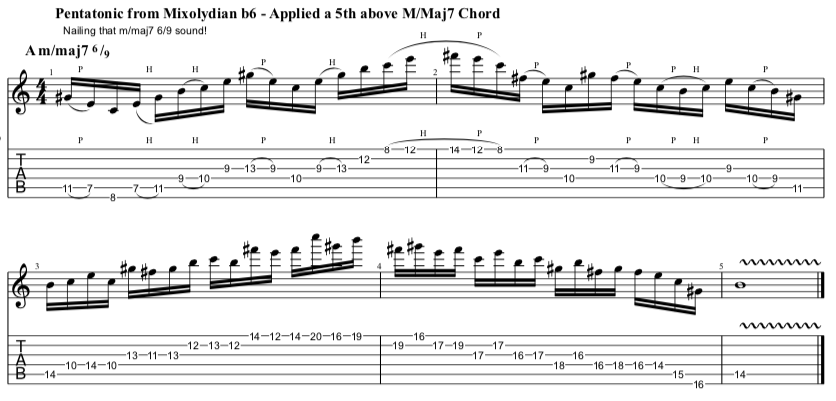Superimposing Mixolydian b6 Pentatonic Over m/maj7 6/9 Chords
Pentatonic scales can be considered abbreviations of larger heptatonic scales, creating focused tonalities that are often audibly different when applied in comparison to their parent scales due to the omission of key intervals.
The most common structure for pentatonic scales is to use the intervals R, 2, 3, 5 and 6 from a larger parent scale. In this case I’ve chosen E Mixolydian b6 scale as the source, and then created a pentatonic scale by removing the 4th and 7th.
Rather than presenting it against the tonic, I thought it would be interesting to hear it against the tonic of the parent scale A Melodic Minor, of which E Mixolydian b6 is the fifth mode. This gives us the chord A m/maj7.
This process of applying one scale on top of another in order to access different intervals against a chord is known as superimposition. I find this particular example interesting as E Mixolydian b6 pentatonic leaves out the root and fourth of A m/maj7 while highlighting the 6 and 9, two pleasing intervals which help to offset the typically unsettling m/maj7 chord.

This example could also be considered bi-tonal because there are two key centres occurring simultaneously. I think the effect is quite audible in this particular example, but regardless I would encourage students to try to understand ideas like this as a means of accessing upper structures of a particular tonic rather than to think about two keys at once for the purposes of practical application.
If this all sounds complicated, don’t be put off; while figuring things like this out can take a certain degree of mental effort, once the method is understood it makes most sense to boil these ideas down to fretboard shapes that you can access and apply, exactly like any other scales or improvisational concepts you may have studied.
Check out more lesson samples here: Free Guitar Lessons
